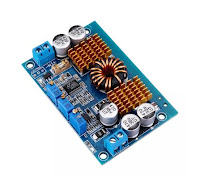Due to some recent instability issues with my switched-mode bench PSU when subjected to a high sudden current demand spike, I decided to get a linear bench power supply. Also, by adding it to my existing bench PSU, I could get a +ve/-ve supply or I could get over 60V if I connect them in series (not quite sure how the CC would work though?).
In particular, I wanted a bench PSU with an Output Enable\Disable switch because I find it useful to be able to set a Voltage and Constant Current setting whilst my test circuit is already connected to the PSU terminals. Why all bench PSUs don't have this is totally beyond me!
One of the few suitable small (cheap) linear bench power supplies was the UNI-T UTP1306S (approx. $100 or £60). I looked at the review on YouTube (see below) before deciding to buy one. I figured that even if it failed on me, at least I would have a nice-looking project case for a future home-made bench PSU!
In particular, I wanted a bench PSU with an Output Enable\Disable switch because I find it useful to be able to set a Voltage and Constant Current setting whilst my test circuit is already connected to the PSU terminals. Why all bench PSUs don't have this is totally beyond me!
One of the few suitable small (cheap) linear bench power supplies was the UNI-T UTP1306S (approx. $100 or £60). I looked at the review on YouTube (see below) before deciding to buy one. I figured that even if it failed on me, at least I would have a nice-looking project case for a future home-made bench PSU!
Note: Another popular PSU is the KA3005D (Bangood affiliate link) (or KA3005P programmable) which actually seems to be better as it has internal relays to control on/off voltage spikes and can be calibrated. It seems to have very low output ripple too.
The first thing I did was to take it apart and inspect it carefully, check soldering, earth connections, tightness of fixings, loose components, etc. The transformer seems remarkably small for a 192W linear PSU...
The first thing I did was to take it apart and inspect it carefully, check soldering, earth connections, tightness of fixings, loose components, etc. The transformer seems remarkably small for a 192W linear PSU...








